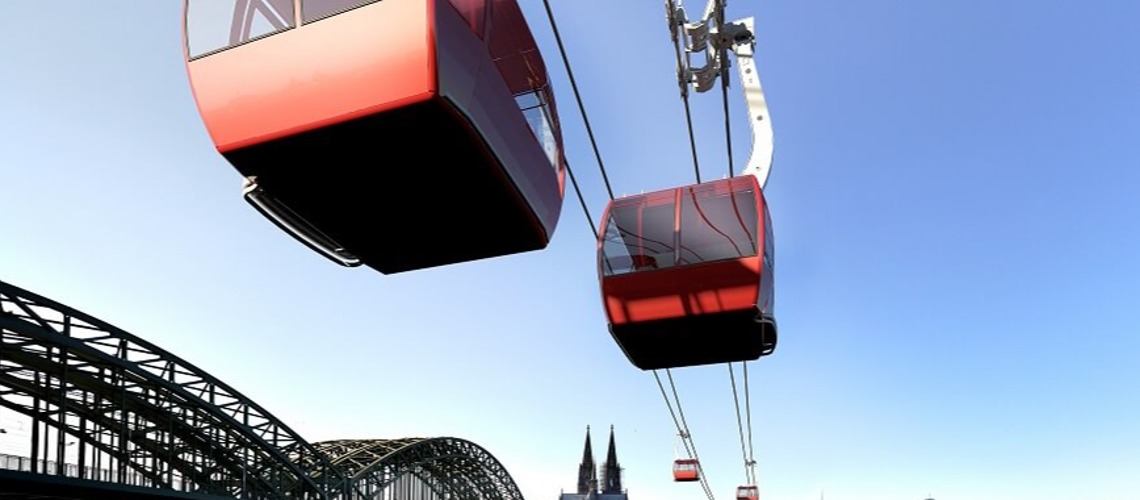Cologne Cable Car - Technical Feasibility Study Is Available

At the meeting on Tuesday, April 25, 2023, the administration recommends that the transport committee consider the cable car system as a public transport service as part of future overall traffic planning. The results of the technical feasibility study are now available and should be included in the sustainable mobility plan "Besser durch Köln" that is to be developed.
The decisive factor for a possible cable car connection is to examine the interaction of the Rhine pendulum with other future traffic measures. In the development process of the sustainable mobility plan, for example, the possibilities of new Rhine bridges, additional light rail lines or the use of a water bus line in connection with a cable car connection will be examined in more detail over the next two years. Which additional public transport offers make sense in the overall concept can therefore only be decided after the mobility plan has been completed.
Cable car routes with the stations in the area of the new Deutzer Hafen district, the Deutzer Werft, the Breslauer Platz (musical dome) and the Rheinpark with a connection to the northern exhibition center were examined. The subjects of the investigation were different technical ropeway systems, a rough dimensioning of the stations, operational processes and an initial cost estimate. According to this feasibility study, for the routes Riehl (Zoo) - Rheinpark, Rheinpark - Breslauer Platz, Breslauer Platz - Deutzer Freiheit and Deutzer Freiheit - Deutzer Hafen, tricable gondolas with cabins for 26 people each would be used, with a transport capacity of 1,500 people per hour make possible. This type of ropeway can operate in wind speeds of up to 100 km/hour,
For the Rheinpark – Messe Nord route, a cable car for 35 people per cabin with a capacity of 930 people per hour is the preferred option. The driving speed was assumed to be 6 m/second (21.6 km/h), so that the driving times would be between 1'33'' and 4'24'' minutes, depending on the route. The urban cable car connection in the Riehl (Zoo) section to Deutzer Hafen would be operated continuously in accordance with the requirements of Cologne's public transport system. The section from the Rheinpark to the exhibition center would be operated temporarily "on demand". If necessary, the user opens the access to the cable car cabin by pressing a button and activates the transport, similar to a building elevator.
The cable car systems of the "inner Rhine pendulum" would be equipped with the so-called "integrated clearance". The safety devices and operational procedures contained therein make it possible for the cabins to be safely returned to the cable car stations and for the passengers to be evacuated via the station's entrance and exit areas.
The required station size varies between 780 m² (Messe Nord) and 3,650 m² (Rheinpark), the supports require between 26 m² and 36 m² of floor space at heights of up to 58 meters (Breslauer Platz/Hohenzollernbrücke).
The cost estimation was made on the basis of simple standard solutions, independent of the layout, execution and design of cable car stations and supports. The investment costs for the route sections are as follows:
- Riehl (Zoo) – Rheinpark 53.2 million euros
- Rheinpark - Messe Nord 19.3 million euros
- Breslauer Platz – Rheinpark EUR 56 million
- Breslauer Platz - Deutzer Freiheit 51.8 million euros
- Deutzer Freiheit - Deutzer Hafen EUR 52.5 million
The estimated total investment sum is therefore 232.8 million euros. Annually around 6.8 million euros would have to be spent on the operating costs.
Background to the sustainable mobility plan "Better through Cologne"
A sustainable urban mobility plan - also called "Sustainable Urban Mobility Plan" (SUMP) - should help to meet the mobility needs of people and companies in the city and the surrounding area with the aim of improving the quality of life. With the "SUMP", strategies and measures covering all means of transport are being developed that are intended to help ensure that the mobility transition continues. The focus here is on consistently promoting the switch to climate-friendly means of transport. It builds on proven planning approaches and pays particular attention to principles of cooperation, participation and evaluation.
Many cities in Europe have now drawn up such a plan. In February 2020, the Cologne City Council commissioned the administration to start the "SUMP" process. The aim is to develop a mobility strategy for the next ten to 15 years and to derive and implement measures from this.













